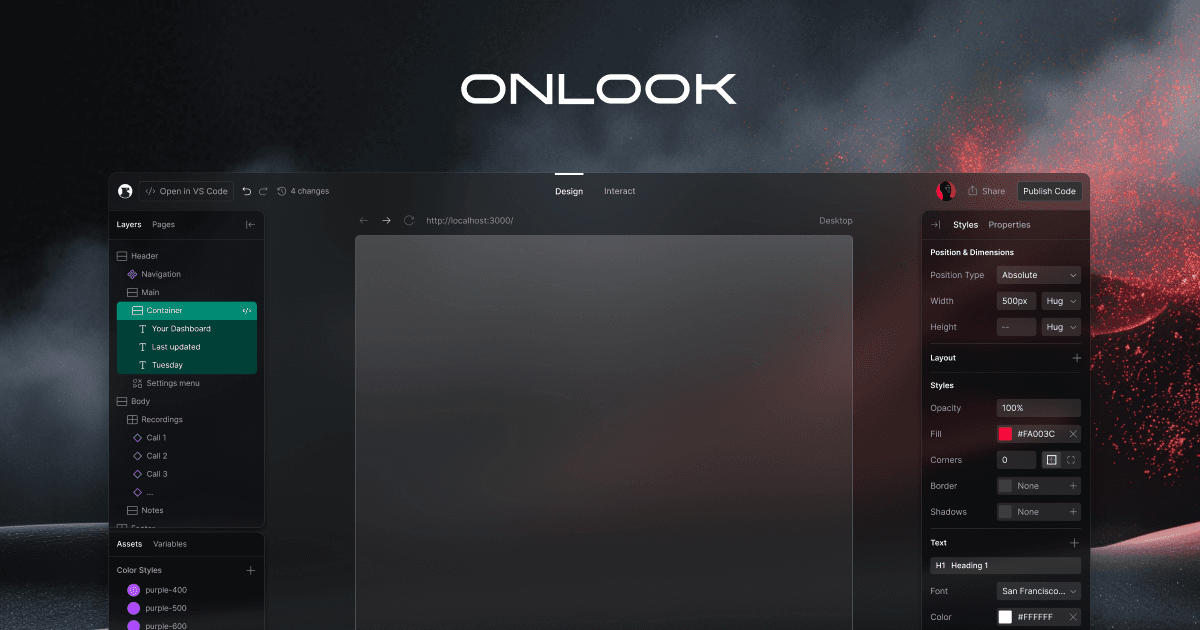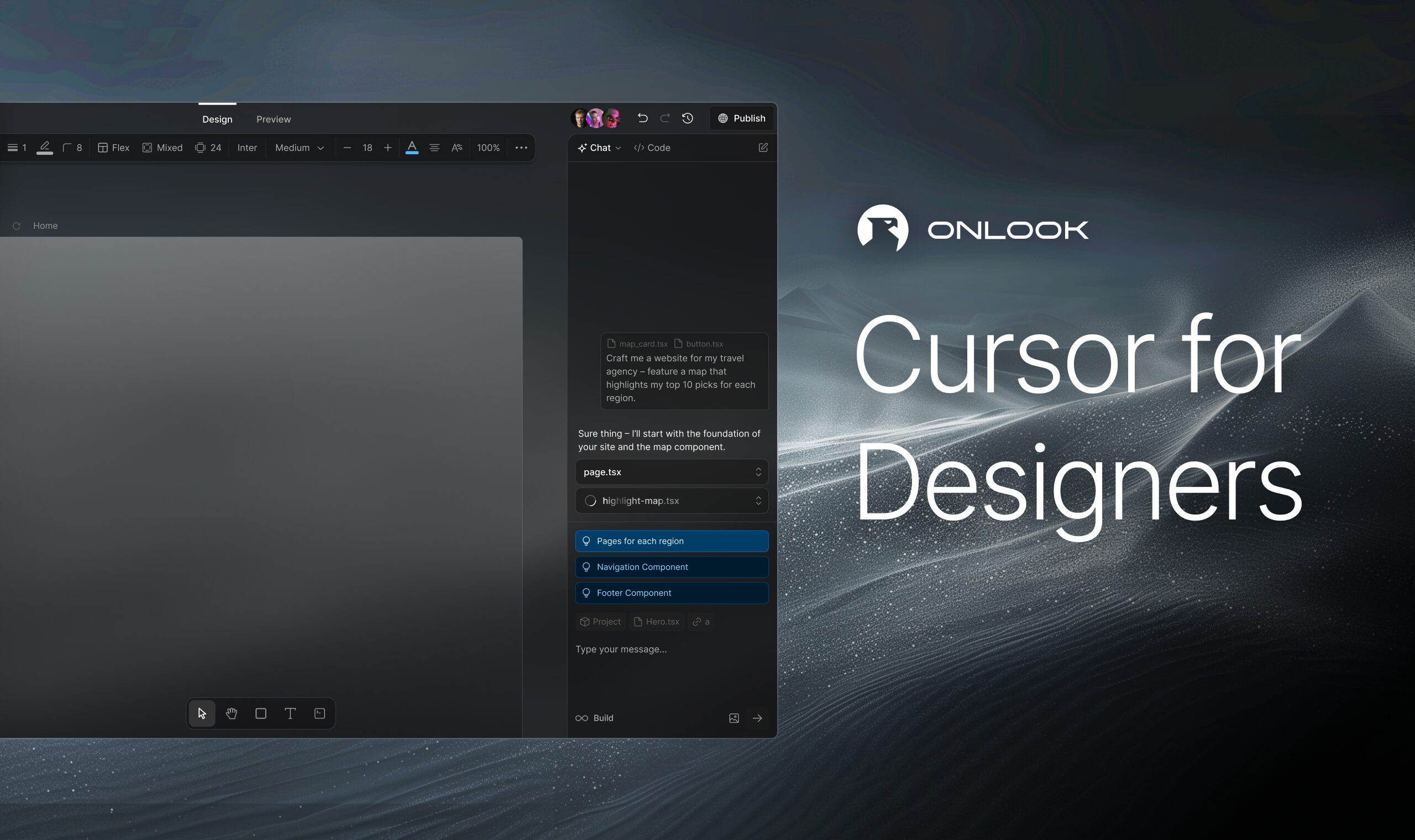
Table of Contents
- Onlook: The Next-Generation Visual Code Editor – A Comprehensive Analysis
- 1. Executive Snapshot
- 2. Impact \& Evidence
- 3. Technical Blueprint
- 4. Trust \& Governance
- 5. Unique Capabilities
- 6. Adoption Pathways
- 7. Use Case Portfolio
- 8. Balanced Analysis
- 9. Transparent Pricing
- 10. Market Positioning
- 11. Leadership Profile
- 12. Community \& Endorsements
- 13. Strategic Outlook
- Final Thoughts
Onlook: The Next-Generation Visual Code Editor – A Comprehensive Analysis
1. Executive Snapshot
Onlook emerges as a revolutionary open-source visual code editor that fundamentally transforms the relationship between design and development in web application creation. Positioned as “Cursor for Designers,” Onlook enables designers and product managers to craft web experiences with artificial intelligence while maintaining direct manipulation of production-ready React code.
Core offering overview: The platform operates as a true developer tool designed specifically for designers, allowing drag-and-drop manipulation, element rearrangement, scaling, and comprehensive editing directly within live React applications. Unlike traditional design tools that require translation layers, Onlook writes code locally to user files, ensuring complete code ownership and eliminating the traditional design-to-development handoff friction.
Key achievements \& milestones: Since launching as an open-source project, Onlook has achieved significant community traction with over 4,200 GitHub stars and more than 40 active contributors, indicating robust developer engagement. The platform has successfully demonstrated its capability to bridge the design-development divide by enabling real-time code generation from visual edits, representing a paradigm shift in how teams approach web application development.
Adoption statistics: The project demonstrates strong momentum within the developer community, with consistent GitHub activity and growing interest from design and development teams seeking integrated workflows. Early adopters report substantial productivity improvements through reduced context switching and enhanced collaboration between design and engineering functions.
2. Impact \& Evidence
Client success stories: Development teams utilizing Onlook report dramatic improvements in workflow efficiency, particularly in scenarios requiring rapid prototyping and iterative design refinement. Designers previously dependent on developer implementation can now directly manipulate production applications, leading to faster iteration cycles and more accurate design implementation.
Performance metrics \& benchmarks: Users experience significant reductions in design-to-development handoff time, with some teams reporting elimination of traditional mockup-to-code translation phases entirely. The platform’s real-time code generation capabilities enable immediate visual feedback, reducing the typical lag between design conceptualization and implementation.
Third-party validations: Industry analysts and technical reviewers have recognized Onlook’s innovative approach to visual development. The platform has been featured in comprehensive comparisons with established tools like Figma and Webflow, consistently highlighting its unique position as a code-first visual editor that maintains developer-grade control while providing designer-friendly interfaces.
3. Technical Blueprint
System architecture overview: Onlook operates on a sophisticated architecture that combines visual editing capabilities with direct code manipulation. The platform runs as an Electron application that connects to React projects, utilizing specially designed instrumentation to map DOM elements to their corresponding code locations. This bidirectional relationship ensures that visual changes translate to accurate code modifications.
API \& SDK integrations: The platform seamlessly integrates with popular development environments including VS Code and WebStorm, providing instant code highlighting and navigation capabilities. Onlook supports comprehensive integration with React and TailwindCSS projects, maintaining compatibility with existing development workflows while enhancing them with visual editing capabilities.
Scalability \& reliability data: Current implementation supports comprehensive React applications with TailwindCSS styling, providing stable performance across diverse project sizes and complexity levels. The platform’s local execution model ensures data security and privacy while maintaining responsive performance during real-time editing sessions.
4. Trust \& Governance
Security certifications: As an open-source platform with local execution architecture, Onlook addresses security concerns through transparent code availability and local data processing. All code modifications occur directly on user devices, eliminating external data transmission and ensuring complete code privacy.
Data privacy measures: The platform’s architecture ensures that code and design data remain entirely under user control. Unlike cloud-based design tools, Onlook processes all information locally, providing enterprise-grade privacy protection without requiring complex compliance frameworks.
Regulatory compliance details: The open-source nature and local execution model naturally align with data protection requirements including GDPR and other privacy regulations. Organizations can deploy Onlook without concerns about external data processing or unauthorized access to proprietary code and design assets.
5. Unique Capabilities
Visual Code Synchronization: Onlook’s revolutionary approach maintains real-time bidirectional synchronization between visual elements and underlying React code. This capability eliminates the traditional gap between design intent and code implementation, enabling designers to work directly with production applications rather than static mockups.
Component-Based Design System: The platform automatically detects and utilizes existing React components within projects, allowing designers to work with actual functional elements rather than simplified representations. This approach ensures design consistency while maintaining component logic and behavior throughout the editing process.
AI-Enhanced Design Workflow: Integration with artificial intelligence capabilities enables rapid prototyping and design generation, allowing users to create comprehensive applications from natural language prompts. This functionality accelerates initial development phases while maintaining code quality and architectural integrity.
Real-Time Collaborative Editing: Multiple team members can work simultaneously on the same project with real-time synchronization, similar to collaborative document editing. This capability enables seamless coordination between designers, developers, and product managers throughout the development process.
6. Adoption Pathways
Integration workflow: Onlook adoption begins with connection to existing React projects or creation of new applications using integrated templates. The platform provides comprehensive project analysis and automatic component detection, enabling immediate visual editing capabilities without extensive configuration requirements.
Customization options: Users can customize the editing environment to match their specific workflow preferences, including tool configurations, component libraries, and styling frameworks. The platform supports extensive personalization while maintaining consistency with established development practices.
Onboarding \& support channels: Comprehensive documentation and community resources facilitate rapid platform adoption. The open-source nature provides access to community support, contribution opportunities, and continuous platform enhancement through collaborative development efforts.
7. Use Case Portfolio
Enterprise implementations: Large organizations benefit from Onlook’s ability to streamline design-development workflows, particularly in scenarios requiring rapid prototyping and iterative refinement. The platform’s code-first approach ensures that design decisions directly translate to production-ready implementations without additional development overhead.
Academic \& research deployments: Educational institutions utilize Onlook to teach integrated design-development concepts, enabling students to understand the relationship between visual design and underlying code structure. The platform provides hands-on experience with modern development workflows while maintaining accessibility for non-technical users.
ROI assessments: Organizations report significant productivity improvements through reduced handoff time, decreased design-implementation errors, and enhanced collaboration between traditionally separate functions. The elimination of mockup-to-code translation phases typically results in substantial time savings and improved final product quality.
8. Balanced Analysis
Strengths with evidential support: Onlook’s innovative approach to visual code editing addresses fundamental inefficiencies in traditional design-development workflows. The platform’s open-source nature ensures community-driven enhancement and transparency, while its local execution model provides security and privacy benefits that appeal to enterprise users.
Limitations \& mitigation strategies: Current platform focus on React and TailwindCSS may limit applicability for teams using alternative frameworks. However, the open-source architecture enables community contributions to expand framework support. Additionally, the visual editing paradigm requires some learning curve adjustment for users accustomed to traditional development approaches.
The platform’s Electron-based architecture may present performance considerations for resource-constrained environments, though local execution typically provides responsive user experiences for most use cases.
9. Transparent Pricing
Plan tiers \& cost breakdown: Onlook operates under a completely open-source model, providing full platform access without licensing fees. This approach eliminates traditional software acquisition costs while enabling unlimited usage across teams and projects of any size.
Total Cost of Ownership projections: Organizations can deploy Onlook with minimal infrastructure requirements, as the platform executes locally without cloud service dependencies. Long-term costs primarily involve internal support and potential customization development, significantly lower than traditional design tool licensing and maintenance expenses.
10. Market Positioning
The visual design software market demonstrates robust growth, valued at approximately \$4.2 billion in 2024 with projections reaching \$9.8 billion by 2033, representing a compound annual growth rate of 9.9%. This expansion reflects increasing demand for integrated design-development workflows and collaborative creation tools.
| Platform | Primary Approach | Key Strength | Integration Model |
|---|---|---|---|
| Onlook | Visual code editing with live React apps | Direct code manipulation | Open-source desktop application |
| Figma | Collaborative interface design | Real-time collaboration | Web-based design platform |
| Webflow | No-code website building | Visual development with hosting | Cloud-based builder |
| Framer | Design-to-code with AI features | AI-powered website creation | Design-focused with code export |
Unique differentiators: Onlook’s code-first approach distinguishes it from traditional design tools by maintaining direct connection to production applications rather than requiring translation layers. The open-source model provides transparency and community enhancement opportunities unavailable in proprietary alternatives, while local execution addresses privacy and security concerns paramount to enterprise adoption.
11. Leadership Profile
Bios highlighting expertise \& awards: The Onlook development team includes experienced professionals with deep expertise in design tools and developer experience optimization. Alex Bacarella serves as a growth marketing leader with expertise in AI integration and user acquisition strategies, bringing valuable experience from previous technology ventures.
Patent filings \& publications: While specific patent information remains proprietary during early development phases, the platform’s innovative approach to visual code editing represents potentially significant intellectual property in the intersection of design tools and development environments.
12. Community \& Endorsements
Industry partnerships: The open-source nature of Onlook has attracted attention from design tool communities and developer advocacy groups. Integration partnerships with popular development tools and frameworks provide enhanced functionality while maintaining platform independence.
Media mentions \& awards: Technology publications and design communities have recognized Onlook’s innovative approach to bridging design-development workflows. The platform has been featured in comprehensive tool comparisons and emerging technology spotlights, highlighting its potential impact on traditional development processes.
13. Strategic Outlook
Future roadmap \& innovations: Development priorities include expanding framework support beyond React and TailwindCSS, enhancing AI-powered design capabilities, and improving collaborative features. The platform’s architecture supports extensibility for additional programming languages and styling frameworks based on community demand and contribution.
Market trends \& recommendations: The trajectory toward integrated design-development workflows aligns with industry trends favoring reduced handoff friction and enhanced collaboration. Organizations should evaluate Onlook’s capabilities in the context of their specific development processes, particularly those involving React-based applications and design-intensive requirements.
The platform’s open-source model provides opportunities for customization and community enhancement that may justify adoption investments for teams seeking long-term control over their development toolchain.
Final Thoughts
Onlook represents a paradigm shift in web development tooling by eliminating the traditional boundary between design and code. The platform’s innovative approach to visual editing with direct code manipulation addresses longstanding inefficiencies in design-development workflows while maintaining the technical rigor required for production applications.
The open-source model provides significant advantages over proprietary alternatives, including complete code ownership, community-driven enhancement, and elimination of vendor lock-in concerns. While current framework limitations may restrict immediate applicability for some teams, the platform’s architecture and community support suggest rapid expansion of capabilities.
Organizations evaluating modern development workflows should consider Onlook’s unique value proposition, particularly for React-based projects requiring intensive design collaboration. The platform’s code-first approach and local execution model address privacy and control concerns while providing the collaborative benefits of modern design tools.
As the development tool landscape continues evolving toward integrated workflows and enhanced collaboration, Onlook’s innovative approach positions it as a potentially transformative force in how teams approach web application creation. Early adoption provides opportunities to influence platform development while gaining competitive advantages through enhanced design-development efficiency.

